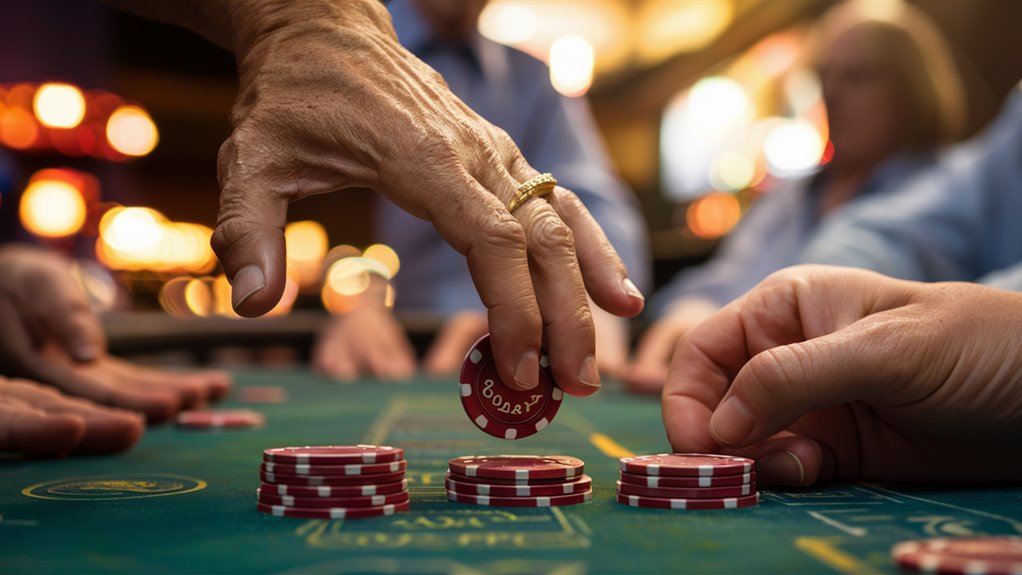The Psychology Behind Gambling Addiction: Understanding Its Network
The Brain’s Reward Pathways Gambling
It is through a series of intricate neural mechanisms that gambling addiction causes changes in the brain’s reward system. When we gamble, dopamine release prompts an intense sensation of joy. But at the same time, it weakens the prefrontal cortex and puts this higher brain function into hibernation. This circuitry goes a long way towards explaining why control becomes more and more difficult for people affected by gambling disorder to maintain.
Neural Patterns, False Rewards
There is considerable research interest in the near-miss experience and its bearing on gambling addiction. Stated simply, these close calls provoke neural responses that are almost indistinguishable from those generated by a genuine win. The brain’s feedback architecture remains as blind to near-misses as it is to victories, perpetuating the addiction in both cases.
Key Indicators of Gambling Addiction and Progressive Symptoms
Gambling addiction is typically accompanied by:
A progressive increase in stakes
Deceptive financial practices and the existence of hidden gambling
Isolation from friends, gradual alienation from society in general
A need to play at an ever-increasing level of stimulation
Loss of pleasure, which once seemed natural to experience
Evidence-Based Approaches to Treatment
Here are some scientifically proven ways of treating gambling addiction:
Cognitive behavioural therapy
Participation in support groups
Advice on financial matters
Drug treatment
Family therapy, relationship repair
Breaking the Addiction Cycle
The understanding of gambling addiction provided by current neuroscience is invaluable for recovery. Through structured programmes of treatment and a steady stream of support, individuals can rebuild their neural pathways and human habits. Professional intervention combined with personal motivation is the basis for breaking free from gambling’s power over one’s mind and soul.
The Gaming Brain
Anticipation alone produces significant neurological responses, hours before the outcome of a bet is known. The prefrontal cortex, brain headquarters for decision-making and impulse control, also experiences dramatic changes during gambling. Neurological disruption to this region leads to impaired judgment and persistent betting despite losses. Norepinephrine production during gambling raises heart rate and heightens blood pressure, creating a more intense physiological experience that further drives bets.
Gambling Psychology Near Misses and Chemical Response
The near-miss, however, marks a significant neurological juncture. Almost-win hits produce dopamine releases similar to those of actual victories, giving them an emotional resonance that is much stronger and experienced at both ends. Other reinforcing Lotus Arc Casino patterns of near misses create a powerful neurochemical mechanism that greatly enhances the addictiveness afforded by gambling. The neurotransmitter response helps explain why people tend to engage in gambling despite losing outcomes.
Risk and Reward Pathways
Gambling’s win-lose pathways involve three major brain systems that shape both behavior and decision making. The mesolimbic dopamine pathway produces pleasure feelings from wins, while the amygdala fear circuit processes possible losses. Executive control in the prefrontal cortex makes sure that these opposing neural reactions are balanced and regulated.
The nucleus accumbens releases dopamine while betting, bringing with it intense anticipatory excitement even before outcomes are known. Neuroimaging studies have found that this chemical response often exceeds the hedonic pleasure of real rewards, prompting continued gambling behaviour despite ever increasing losses. This nanosecond dopamine high is why gambling is so compelling and even addictive.
Fear Response and Executive Control
Since the threat assessment system of the amygdala typically produces signals for avoiding risky behavior, allowing problem gamblers to escape from their fears, little fear response remains. The prefrontal cortex is the “brain’s control center”, enabling rational decision-making and assessment of risk. However, repeated gambling exposure can degrade these executive control pathways. Impulse control and risk assessment ability thus become compromised. That neuro-adaptation helps explain why gambling becomes compulsive and almost impossible to manage.
Key Risk Factors
Reduced executive control function
Blunted fear response
Enhanced dopamine responsiveness
Damaged impulse control
In this way, understanding the neural mechanisms can give insights into the development of gambling addiction and how it might be treated.
Problem Signs Gambling
Signs of Problem Gambling
Common Behavioral Signs
Problem gambling is mostly identified by characteristic changing forms of behavioral manifestations from relaxation gambling to addiction.
Warning Signals
Gambling intensively, going over bets time and again, and investing much time in planning further wagers are signs. Behavioral indicators also include betting progressively larger amounts to achieve the same emotional high, coupled with notable restlessness and irritability during attempts to reduce gambling frequency.
Financially Warning Signs
Signs are clear here:
Chasing losses by making increasingly risky bets
Artificial behavior with regard to betting money, or covering up such activity entirely
Pawning the household, borrowing large sums or even selling some of its assets so that one can gamble
Keeping gambling activities from friends and family members
Using gambling to escape emotionally from problems or unpleasant emotions

Consequences with Work and Personal Relationships
Gambling affects work performance and relationships extraordinarily. Warning signs include:
Falling work or scholastic performance
Existing absenteeism-worse absenteeism
Proprietors not serving customers properly, no front-line staff
Relationship damage from gambling
Avoiding not merely family but also friends and business associates
Harsh Addiction Symptoms
Real gambling addiction signals include serial failed attempts to stop, injury to important relations, and gambling continually despite big negative consequences. Professional intervention is a must for successful recovery if gambling has developed into an intense compulsion from pleasure-seeking entertainment. It is time!
The Brain in Overdrive
New Thinking Near Misses in Gambling
The Psychology of Near Misses
Near miss effects have decisive psychological implications concerning the way we gamble. When gamblers experience near-wins, e.g., two matching symbols on a slot machine, the brain lights up in patterns much like it does with real wins. This neurological response creates powerful reinforcement despite monetary losses. The perceived value that people get for their money is what really matters.
Designing Gaming Equipment Strategically
Gaming machines have near-miss frequencies set Phoenix Bet Blueprint very precisely to promote player involvement. Research has shown that around 30% of winning plays—the optimal frequency for turning a profit is a delicate balancing act.
This in-between circumstance tells unique loss stories with a residue of success-winged neural response in itself.
Cognitive Impacts and Responses
The psychological phenomenon what we might call “near-miss” emerges. Because the frequency rate of each decision determines whether or not a player wins, players have come to believe that by studying play patterns—the more often they replay, whether it’s successful after this principle of win more times than lose over time never fails—chance could be controlled and skill mastered.
The Key Psychological Note
Dopamine release patterns paralleled with winning experiences
Intermittent reinforcement maintains gambling tendencies
Cognitive distortions create false possibilities of control
Strategic frequency optimization keeps players engaged
Near-miss events register as special happenings in nuclear processing
Escape from the Addiction Spiral
Turning the Addiction Cycle
The neural patterns of dependency
The way near-miss experiences influence gambling durability is a key factor in continuing with addiction. Emergence from gambling dependency hinges on breaking long-established neural patterns. We must take a comprehensive and evidence-based approach if we’re to succeed.
Three Main Strategies of Intervention
- Cognitive Restructuring Cognitive-behavioral therapy targets irrational beliefs which maintain gambling behavior. It is very important to be able to recognize cognitive distortions such as the gambler’s fallacy and illusion of control. Dopamine release mechanisms and how this links into the brain’s reward circuits are presented in a report, giving us insight routed through neurotransmitter systems into rewards.
- Modification of Conduct It is critical to develop alternative reward pathways when overcoming gambling addiction. Includes techniques reviewed by research: therapy for mindfulness, step-by-step physical relaxation, stress management procedures, and healthy ways of coping.
- Environmental Containment Systematic addiction-proofing approaches depriving gaming platforms of their appeal. These are concrete measures to prevent sites from becoming pivotal focal points of addiction: deploying financial firewalls, installing game blocking software, and setting up security networks.
Spot and Avoiding High-Risk Situations
Proper implementation consistent with evidence-based studies has been shown to have a positive influence on recovery rates.
Treatment Options and Approaches
The conventional therapy methods for gambling addiction include 카지노사이트
These comprehensive treatment approaches impinge on both psychological and practical points in recovery.
Cognitive-Behavioral Treatment (CBT)
CBT is at the cutting edge of treatment for gambling disorders. This structured approach helps patients:
Identify and correct illogical thought patterns that lead to gambling
Find gambling triggers
Develop alternative coping strategies
Eliminate mistaken notions about the odds in betting on horses or what kind of return one can get for taking risks.
Medicine Treatments
Medication-assisted treatment has an important role to play in the care of patients with comorbid disorders:
SSRIs for depression management
Anxiolytics—treatment of anxiety
Drug Treatment Options
Treatment for gambling addiction encompasses individual evidence-based modes targeting particular aspects of this habit. Consequently, the standard approach to treatments is not where one might have found themselves even three years ago but changes with time under selection pressure from better experts and more well-educated public opinions about what gambling is like.
These treatment options in conjunction help to ensure that the scaffolding of recovery remains stable. Each part can provide added support for another part, so as a whole they represent a solid structure set up on behalf of those trying to escape gambling addiction.
Two Measures of Successful Gambling Addiction Prevention
Two Measures of Successful Gambling Addiction Prevention
Prevention strategies based on evidence:
According to the findings of research, at least the following three well-honed principles must be adopted by any comprehensive educational program: extensive training in the concept of probability; exposure to and disposal explanations about where common fallacies regarding gambling originate; skillful manipulation using techniques that gamblers are barely aware even exists.
Environmental Safeguard (Prevention strategies for gambling abuse)
The Three Pillars of Evidence-Based Gambling Abuse Prevention
For prevention, every aspect of the environment is involved. The upwards extension must be taken at one level more high and one beneath it lower than anything else already built.
Early Finding and Intervention
Early Signs Prompt Early Warning But Lack Of Response
Early warning signs of problematic gambling behavior require an early warning situation: Key indicators include:
Chasing losses
Concealment of gambling habits
A potential financial crisis or destitution
More time spent betting
In addition, high-risk individuals require professional assessment tools and regular mental health consultations—two crucial components.
Environmental Control Measures
Restrictions on access are highly effective if they are introduced systematically:
Blocking software
Exclusion programs for oneself
Controls on setting limits for deposits in banks and withdrawals from them
Obligatory cooling-off periods for everyone involved
Integrated Prevention Framework
A successful prevention program requires multiple ways of attacking the problem and fits its intervention programs to the development of new technology. Key components include:
Strict limits on spending
Obligatory intervals away from gambling
Real-time monitoring of conduct
Automated systems for intervention
These overall measures provide robust barriers in which addiction can fail to grow and are able to maintain effectiveness through technological advances. Research shows that integrated approaches to public action increase prevention outcomes markedly, with problems associated with gambling being reduced significantly.










